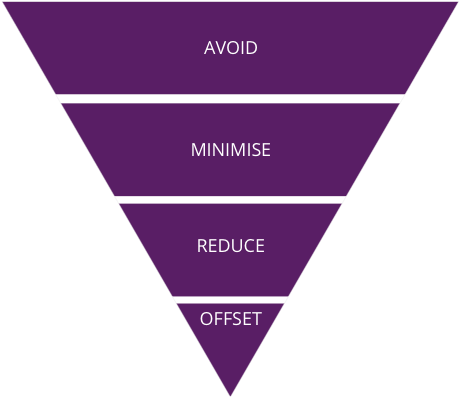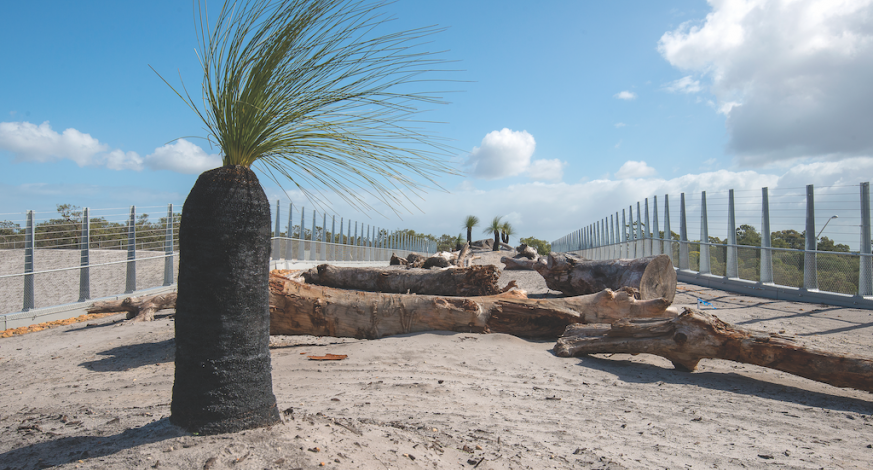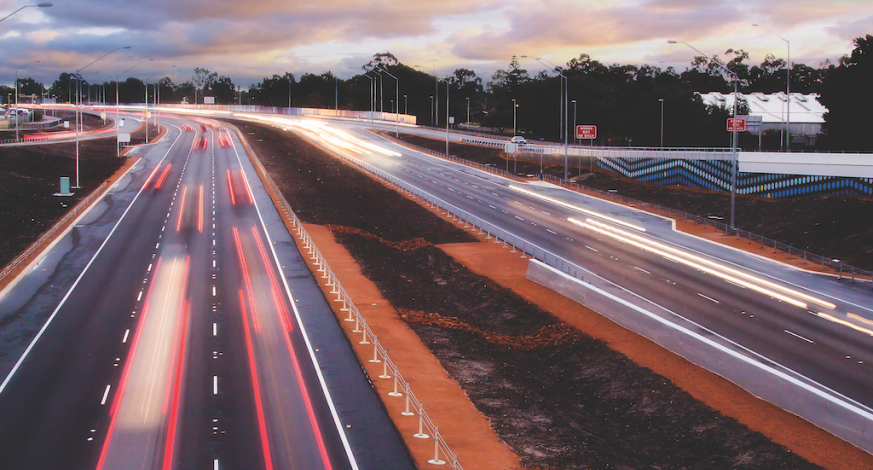Sustainability Assessment in Projects and Operations
For our highest value major projects we have adopted the Infrastructure Sustainability (IS) rating tool, Australia’s only comprehensive rating system for evaluating sustainability across design, construction and operation of infrastructure. All infrastructure projects exceeding $20 million utilise the IS framework as part of project development and evaluation. Three programs and two individual projects have been registered for an IS Rating.
The Bunbury Outer Ring Road is the first ever project registered for an IS Planning Rating. The NorthLink Southern Section was verified as having a Leading As Built rating of 95.2 points, the highest under IS to date.
Stand-alone public sustainability reports are produced for our projects with IS obligations. This year a Public Sustainability report was submitted by: Great Northern Highway Muchea to Wubin Stage 2 Upgrade; NorthLink WA – Central Section: Reid Highway to Ellenbrook; NorthLink WA Northern Section: Ellenbrook to Muchea; the Metropolitan Roads Improvement Alliance; Kwinana Freeway Northbound Widening; Smartways Alliance; Wanneroo / Ocean Reef Road and Marble Bar Road – Coongan Gorge Realignment. For more information on IS and to view the project sustainability reports please go to our website.
The following table lists all projects greater than $100 million that have been formally registered for an IS rating and their current status.
| Great Northern Highway Muchea to Wubin Stage 2 Upgrade |
| Overall Program |
1.2 |
First Round Interim Design |
Commended |
Commended |
| Muchea North |
1.2 |
As Built (complete, not verified) |
Commended |
Commended |
| New Norcia Bypass |
1.2 |
As Built (complete, not verified) |
Commended |
Commended |
| Walebing |
1.2 |
As Built |
Commended |
Commended |
| Miling Bypass |
1.2 |
As Built (complete, not verified) |
Commended |
Commended |
| Miling Straight |
1.2 |
As Built (complete, not verified) |
Commended |
Commended |
| Pithara |
1.2 |
As Built |
Commended |
Commended |
| Dalwalinu to Wubin |
1.2 |
As Built |
Commended |
Not Started |
| NorthLink WA |
| NorthLink WA Southern Section |
1.2 |
As Built |
Excellent |
Verified Leading for Design
Verified Leading for As Built |
|
NorthLink WA Central Section
|
1.2 |
Design |
Excellent |
Leading |
| NorthLink WA Northern Section |
1.2 |
Design |
Excellent |
Leading |
| Mitchell Freeway |
| Mitchell Freeway Extension |
1.0 |
As Built |
Commended |
As Built
Rating Abandoned |
| Metropolitan Roads Improvement Alliance |
| Armadale Road |
1.2 |
Design |
Excellent |
Excellent |
| Murdoch Activity Centre |
1.2 |
Design |
Excellent |
Excellent |
| Wanneroo Road Duplication |
1.2 |
Design |
Excellent |
Excellent |
| Armadale Road |
Armadale Road
Northlake Road Bridge |
2.0 |
Design |
Silver |
Silver |
| Bunbury Outer Ring Road |
| Bunbury Outer Ring Road |
2.0 |
Planning |
Bronze |
Bronze |
The following table provides information on projects valued between $20 and $100 million and subject to internal self-assessment using the IS rating tool and current status.
| Swan River Pedestrian Bridge - Matagarup Bridge |
1.0 |
As Built |
Commended |
Commended, Complete |
| New Lord Street |
1.2 |
As Built |
Commended |
Commended |
| Nicholson Road Bridge Over Rail |
1.2 |
As Built |
Commended |
Commended, Complete |
| Great Northern Highway - Wyndham Spur to Maggie's Jump Up |
1.2 |
As Built |
Commended |
Excellent, Complete |
| SMART Freeways |
1.2 |
Design |
Excellent |
Behind |
| Marble Bar Road - Coongan Gorge Realignmnent |
1.2 |
As Built |
Excellent |
Behind |
| Mitchell Freeway Southbound Widening |
1.2 |
Design |
Excellent |
Behind |
| Kwinana Freeway Widening Northbound |
1.2 |
Design |
Excellent |
Excellent |
| Wanneroo / Joondalup Interchange Project |
2.0 |
Design |
Silver |
Silver |
Emissions and Energy
Developing, operating and using a road network consumes energy and generates emissions in numerous forms including carbon emissions, noise, vibration and other air pollution such as carbon monoxide, nitrogen dioxide, and particles. The predominant impacts from energy and emissions fall outside our direct control and arise from use of the road network itself. Urban air pollution is a known carcinogen and has a range of human impacts. Globally air pollution contributes to more deaths than road accidents. Of all the pollutants assessed, PM2.5 (tiny particles of matter, one‑fortieth the width of a hair) is considered to present the greatest potential impact to our health. No level of air pollution is completely safe for humans. Motor vehicles are a significant contributor to emissions, contributing 14 per cent of PM2.5, and 62 per cent of nitrogen oxides.
Road transport makes up 15 per cent of Australia’s total emissions and has been the highest growing source of emissions since 1990. We estimate that the road network generates carbon emissions at a rate of 288.7 t CO2-e per million vehicle kilometres travelled (MKVT). In 2018–19, MKVT was 27,401 and thus emissions were approximately 7.9 mt CO2-e from use of the road network.
Our current approach has focused on reducing our direct energy use and emissions generation but we are aware of our ability to influence outcomes from our contracts and from the road network use.
For example, travel times have improved in locations across the network including by up to two minutes along Marmion Avenue during peak periods. Reducing delays and stop-start traffic has a positive effect on carbon emissions from the road network.
Noise and vibration is produced and influenced by the road network in a number of ways including from vehicles, infrastructure and road design, construction and maintenance activities. Installation of noise walls is an example of a mitigating activity.
Carbon Reduction Plan
We have a Carbon Reduction Plan and Target, 5 to 15 per cent reduction on 2010 levels by 2020, focused on Scope One and Two emissions and have had a Climate Change Adaptation Plan since 2011. Our total emissions across our facilities over the past year were 25,110 CO2-e, achieving our target which was to be below 27,925 CO2-e.
In December 2017, the State Government signed a Memorandum of Understanding (MOU) for Sub-National Collaboration on Electric Vehicles (EVs).
The MOU is an output of the Climate Action Roundtable. Together with Western Power, we were nominated joint lead to ‘Take a coordinated approach to the strategic planning and construction of infrastructure for EVs’. In response, we commissioned UWA to undertake research into the need for State-wide EV Charging Infrastructure in WA. The report has been finalised and it is intended to be tabled in Parliament.
Emissions Metrics
| GHG Type (t CO2) |
2017 |
2018 |
2019 |
| Fuel* |
2,860 |
3,088 |
3,150 |
| Street and traffic lights |
16,804 |
18,614 |
23,497 |
| Buildings |
4,230 |
4,183 |
3,834 |
| Air travel* |
271 |
331 |
527 |
| Projects and maintenance fuel use* |
8,010 |
27,661 |
40,686 |
| Waste* |
8,391 |
10,2241 |
19,317 |
| Offsets |
-1,183 |
0 |
-2,749 |
| Total |
44,472 |
53,877 |
88,262 |
| GHG Type (t CO2) |
2017 |
2018 |
2019 |
| Scope 1 |
3,046 |
3,296 |
3,347 |
| Scope 2 |
20,848 |
24,578 |
24,578 |
| Sub Total |
23,848 |
27,925 |
27,925 |
| Offsets |
-1,183 |
-2,749 |
-2,749 |
| Total |
22,711 |
25,886 |
25,176 |
| Scope 3 |
19,772 |
38,232 |
60,530 |
| Energy Source |
2017 |
2018 |
2019 |
| Electricity usage (Mj) (within) |
105,404 |
116,622 |
126,677 |
| Fuel and gas usage (Mj) (within) |
45,095 |
47,353 |
49,387 |
| Projects and maintenance (outside) |
290,651 |
374,828 |
548,371 |
| |
2017 |
2018 |
2019 |
| Mj per km State Road |
8,101 |
8,850 |
9,480 |
| Scope 1 & 2 t CO2 per km State Road |
1.29 |
1.40 |
1.50 |
Climate Change Adaptation
We have identified more than 50 kilometres of State Roads that have been assessed to warrant earlier, more detailed evaluation for the impacts of climate change. The indicative replacement value of this at-risk infrastructure is in the order of $165 million. A fundamental aspect of our Sustainability Policy is climate change. Our Key Aspect Management Plan for Climate Change includes a progressive approach to embedding adaptation practice into standards and asset management practices. An important activity was embedding resilience into our asset management framework.
Materials for Road Building
Natural materials are crucial in road building. Our philosophy on materials use is to minimise lifecycle impacts, including embodied energy, and to follow the hierarchy of reduce, re-use where possible, and recycle materials to their highest end-use possible. When obtaining road-building materials, we endeavour to avoid clearing natural vegetation. On-site materials unsuitable for use in road construction are used, as appropriate, for rehabilitating areas where road-building materials were obtained.
We also seek to incorporate recycled content into the significant materials used for road construction. Recycled content includes crumbed rubber, glass, asphalt and concrete. We have intent to contribute to developing the circular economy in WA.
Crush Recycled Concrete (CRC) is a road building material making up 50 per cent of Western Australia’s waste stream. We recognise our role in establishing an ongoing practice for the use of this material. A key project has been a collaboration with the Department of Water and Environmental Regulation (DWER), the Waste Authority and Industry to pilot the Roads to Reuse Program. A new product specification, that enables CRC to be used as road sub-base, has been released by DWER to manage the risk of contaminates including asbestos. Two infrastructure projects, Kwinana Freeway Northbound Widening and the Murdoch Drive Connection have been identified to use up to 25,000 tonnes of CRC under the product specification in 2019-20. Under the Waste Strategy 2030, we have committed to increasing our use of CRC to 100,000 tonnes.
Waste tyres are another significant challenge of the Waste Strategy 2030. We currently utilise crumbed rubber in resealing works, which could potentially be sourced using recycled tyres. We have committed to develop and implement alternative crumbed scrap rubber bituminous binders to double our and local government’s usage to over 1,200 tonnes per year.
Imported Road Construction Materials
| Indicator (t) |
2017
(000) |
2018
(000) |
2019
(000) |
| Sand |
768.7 |
5,722.9 |
2,678 |
| Gravel |
1,244.4 |
1236.7 |
2,037.9 |
| Crushed rock |
404.3 |
684.5 |
825.7 |
| Limestone |
462.2 |
814.4 |
520.9 |
| Aggregate |
83.8 |
172.6 |
45.2 |
| Asphalt |
202.5 |
403.9 |
422.7 |
| Bitumen |
781.5 |
1284.4 |
40.8 |
| Bitumen Cutter |
85.9 |
223 |
36.6 |
| Emulsion |
120.2 |
789.2 |
27.0 |
| Concrete and steel |
244.9 |
152.2 |
56.0 |
| Concrete |
- |
- |
32.0 |
| Cement stabilised backfill |
- |
- |
12.0 |
| Mulch |
- |
- |
12.0 |
| Other (steel, paint, glass, primer, topsoil) |
2.6 |
67.5 |
19.0 |
Imported Recycled Construction Materials
| Indicator (t) |
2017
(000) |
2018
(000) |
2019
(000) |
| Sand |
4.8 |
0 |
99.6 |
| Road base |
0 |
33.9 |
66.3 |
| Asphalt / profiling |
6 |
2.1 |
14.4 |
| 14.4Crushed glass |
0 |
17.1 |
7.4 |
| Rehabilitation purposes - unsuitable material |
4.2 |
7 |
88.5 |
| Other (crumbed rubber, limestone, plastic, concrete, steel, topsoil, mulch) |
0.1 |
0.6 |
0.8 |
| Imported construction materials with an eco label |
0 |
6 |
1.5 |
Waste Materials to Landfill (Waste)
| Indicator (t) |
2017
(000) |
2018
(000) |
2019
(000) |
| Kerbing / concrete |
0..6 |
0.02 |
2.4 |
| Existing seal |
0.05 |
3.0 |
2.5 |
| Unsuitable material |
5 |
39 |
77 |
| Site office / general waste |
- |
0.04 |
2.2 |
| Other (roadside litter / waste, plastics) |
0.4 |
0.1 |
0.02 |
Materials Recycled
| Indicator (t) |
2017
(000) |
2018
(000) |
2019
(000) |
| Sand |
0.6 |
73.7 |
162.2 |
| Road base |
0.0 |
3.6 |
46.8 |
| Asphalt / profiling |
6.2 |
24.8 |
17.0 |
| Steel |
0.9 |
0.6 |
0.24 |
| Concrete |
6.7 |
0.3 |
12.6 |
| Office waste, general, roadside litter |
3.0 |
1.6 |
0.7 |
| Timber |
|
0.2 |
0.9 |
| Rock |
- |
- |
89.4 |
| Other (green waste, plastic, topsoil, hydrocarbons) |
0.0 |
0.0 |
0.5 |
Waste Management: Roadsides, Buildings and Facilities
Controlling roadside waste across the State’s road network requires ever-increasing attention. We collaborate with key stakeholders, interested parties and community groups for a consistent litter management approach taking into account individual regional requirements. We continue to implement our State-Wide Litter Plan developed with the primary objectives of educating road users to take their litter with them and to reduce littering and illegal dumping. Implementing the plan involves boosting public awareness as well as increasing community buy-in and participation in litter reduction programs and behaviours.
Our commitment to improved waste management practices is evident in the design, construction, operation and ongoing management of our offices and depots. These incorporate waste management principles in design and construction, achieving five-star Green Star and NABERS ratings. Our offices have waste avoidance strategies and our depots have waste management plans for materials such as asbestos, concrete, steel, aluminium, batteries and waste oil. The separation of general office waste and recyclables is encouraged by providing paper, battery and printer cartridge recycling facilities.
We are reducing single-use plastics in the Don Aitken Centre by using alternative bin liners, replacing disposable cups with a biodegradable paper product and completely removing plastic cups from several building levels.




